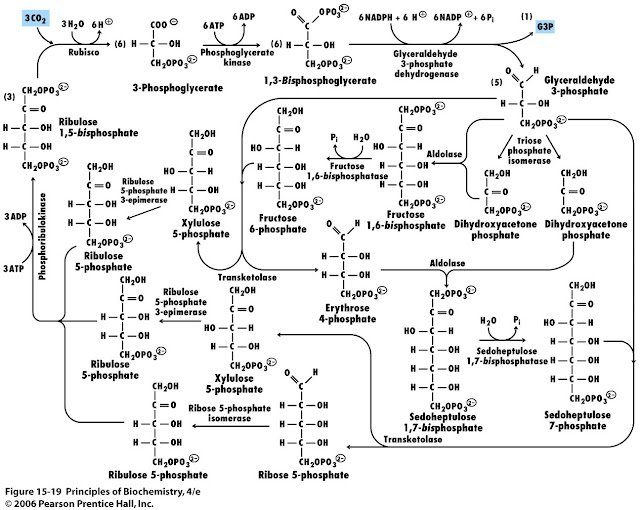Daily Newsletter
October 8, 2013 Carbon Fixation & Calvin Cycle
Our first stop in understanding photosynthesis is to first look at the autotrophic aspect, i.e., how we take Fix CO2 into organic carbon, and then reduce the resulting carbon compounds to produce glucose (Calvin Cycle).
One of the most important reactions in biology is the carbon fixation step of the Calvin Cycle. This is not hyperbole. This one stage of the Calvin cycle is the major way that CO2 is maid available to living systems. CO2 is a highly oxidized compound, and is considered an inorganic compound. It is also very stable. We have to some how take this compound and add it to an organic structure, thereby making it available to other living systems. This is the critical step in autotrophy.
[NOTE: Some bacteria can use other biochemical pathways for carbon fixation, but the vast majority of carbon fixation will occur in reactions similar to that which occurs in the Calvin Cycle.]
Consider what it means to have bioavilable carbon (i.e., carbon usable by non-autotrophic organisms). Consider what you ate today? Did it consist of starches, vegetables, animal products? Did it have protein, carbohydrates, lipids? All of these are organic (biochemical) molecules. They are all made of carbon, and we can consider them derivatives of Carbon Fixation. You may have heard that all of our energy comes from the sun; well the carbon fixation reaction is where we get the carbon to hold that energy (i.e., reducing power).
Above is a great diagram of the carbon fixation step in the Calvin Cycle. CO2 is added to the second carbon (carboxylation). There is an unstable intermediate that is formed, which spontaneously splits into two molecules of 3-Phosphoglycerate (3GP).
Ribulose 1,5 Bisphosphate Carboxylase (RuBisCo) is the enzyme that catalyzes the carbon fixation step. This enzyme is often cited as the most abundant enzyme on the planet, which is most like the case. No one though could doubt that it is the single most important enzyme, for without this, we would not have the quantity of organic carbon that is needed to support life as we know it.
Carbon Cycle
One area of study in ecosystem ecology is the cycling of nutrients through the environment, and one of the most critical cycles is the Carbon Cycle. The diagram below is a simple depiction of the carbon cycle, and
Is there other carbon? Yes! There are fossil fuels, limestone deposits, and other geological carbon sinks. But it is the relationship between photosynthesis and respiration that is the strong and dynamic feature of the carbon cycle. The step of Carbon Fixation is the critical reaction.
RuBisCo
Ribulose 1,5 Bisphosphate Carboxylase is a fascinating enzyme, and has been the subject of a great deal of research. As the name implies, the substrate is a five carbon sugar (ribulose) that contains two phosphate, bound to the 1st and 5th carbon respectively. It's action is to add a carboxyl (CO2) group to the ribulose 1,5-bisphosphate.
It is also an enzyme that can carry out the reverse reaction, and can do so quite easily (which is a problem). This is one of the few enzymes where equilibrium becomes important. There is a problem known as photorespiration where RuBisCo reverses, and starts releasing CO2.
Calvin Cycle
Remember: we can break the Calvin Cycle into three stages: Carbon Fixation, Reduction and Regeneration.The diagram to the right gives a little more detail on these stages. Above, we discussed the carboxylation of ribulose 1,5-bisphosphate (Carbon Fixation). We must now look at the rest of the cycle.
The product of the carbon fixation reaction, Phosphoglycerate (PGA) is the the substrate for the reduction stage of the Calvin cycle. As the diagram shows, this is where ATP and NADPH + H+ is used. The reduction stage ends with the production of Glyceraldehyde 3-P (G3P). Two out of every 12 molecules of G3P created will be used to make a hexose (e.g. glucose). The other 10 molecules of G3P will be used to regenerate the 5 carbon RuBP. The conversion of G3P to RuBP is the regeneration step.
Note that the calvin cycle must run multiple times to get a single glucose molecule. 6 RuBP must be carboxylated. 12 PGA must be reduced. 10 G3P must be regenerated. It is not as simple as glycolysis and citric acid. Consider, you have to take 10 three-carbon structures, and convert them into 6 five-carbon structures during the regeneration steps; how do you do that?
The following diagram gives you some of the complexity of the Calvin cycle. You are not required to memorize this, but with your growing knowledge of reactions, you may find you can follow it.
If you notice, the set of reactions at the top of the image show the Carbon Fixation and Reduction steps. Everything else deals with regeneration. Recall that with glycolysis and citric acid, the intermediates were used for other reactions. The same thing is happening here. These intermediates of the regeneration stage can be used for other chemical processes.
Daily Challenge
In your own words, discuss the connection between this step and the events of glycolysis and the citric acid cycle. Where did decarboxylation take place? Why is RuBisCo and the carbon fixation reaction so critical? How would you turn Glyceraldehyde 3-P formed in the Calvin cycle into glucose? Can you figure out the reactions in the regeneration steps? Why did we need NADPH?Link to Forum


No comments:
Post a Comment